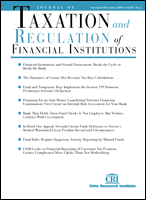Complete Issue
Author: Houman B. Shadab.
Source: Volume 24, Number 06, July/August 2011 , pp.1-64(64)

< previous article |return to table of contents
Abstract:
Much American wealth and savings is stored in federally regulated, registered investment companies (RICs), more commonly known as mutual funds. An important tax issue for RICs is how cancellation of debt income—which arises from the discharge of a loan owed by the RIC—is treated for the purposes of the gross income test. As explained by Timothy J. Becker and Joshua R. Williams in our first article, the gross income test is important because it helps to determine whether an investment company will qualify as a RIC for federal tax purposes. As the authors note, however, how income from the discharge of indebtedness is treated for purposes of the gross income test is unclear, and accordingly the authors describe the need for guidance in the area and propose their own framework. In our second article, Susan Nevas provides a comprehensive analysis of the Internal Revenue Service’s second Notice on the Foreign Account Tax Compliance provisions of the HIRE Act (FATCA), which was released on April 8, 2011. Ms. Nevas notes that while the Service’s first Notice sought a balanced approach toward ensuring that compliance was not overly burdensome, on the one hand, and achieving FATCA’s goal of preventing evasion of U.S. tax law through foreign financial institutions, on the other, the second Notice places a premium on compliance by, for example, establishing new rules for foreign institutions to identify private clients. Legal and business commentators have noted a recent trend in the business world generally: the increased use of entity structures other than corporations, especially the various types of partnerships and limited liability companies. In our third article, Joseph Mandarino notes that financial assets are finding their way into many of these non-corporate entities, which are treated as partnerships for federal tax purposes and he provides a primer on tax issues that arise when partnership interests are transferred to address this increasingly common tax situation. While commercial real estate never experienced the losses--or caused the types of systemic dislocations--as their counterparts in the world of residential real estate, commercial real estate nonetheless became highly distressed during the recent economic downturn. As a result, banks have found themselves saddled with commercial real estate assets, typically acquired through foreclosures. Our fourth article, by Larry Woodard, offers practical strategies banks can use to minimize losses in selling such commercial “other real estate owned,” with the key being for a bank to develop the longer-term mentality of an owner, and not a mere seller. The broader issue of bank exposure to mortgage assets touches on our last article, by Genci Bilali. In the aftermath of the financial crisis, renewed attention has turned to whether states can enforce their own consumer regulatory and oversight regimes over national banks without running afoul of federal banking law that preempts state authority. Mr. Bilali offers an overview of how the Dodd-Frank Act (the Act) addresses federal bank preemption law in the consumer protection field. As he notes, while the Act is mostly consistent with existing bank preemption law, it does give states a broader range of influence and power over national banks operating within their borders.Keywords:
Affiliations:
1: New York Law School.